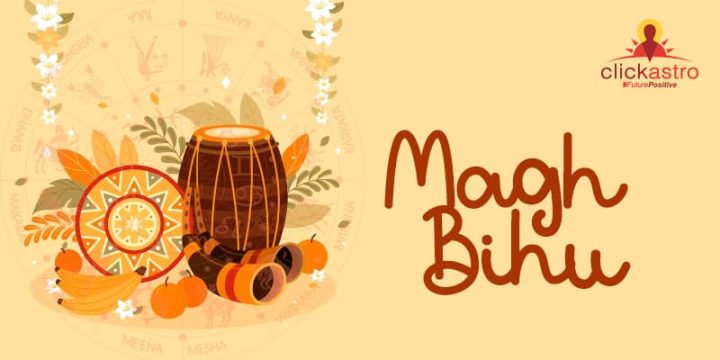Introduction
Magh Bihu, known as Bhogali Bihu, stands as a vivid representation of Vedic culture sewn together with the threads of tradition and agricultural vibrancy in Assam and other parts of North-East India. Embedded in the soil of centuries-old agricultural practices, this festival resonates deeply with the local communities, symbolizing the conclusion of the harvesting season and the anticipation of a flourishing spring.
The 2025 Magh Bihu will be celebrated on January 15, Wednesday.
As the air becomes infused with the aroma of festive fervor, families come together to partake in customs and rituals that have been passed down through generations. From the construction of Meiji structures to the jubilant feasts on Bhogali Uruka, Magh Bihu encapsulates a unique blend of spiritual gratitude and communal celebration.

This blog will delve into the intricate details of the festival, unveiling the layers of significance that make Magh Bihu not merely an event but a cultural cornerstone, fostering unity and embracing the abundance yielded by the fertile lands of Assam.
Origin and Historical Significance
Magh Bihu, tracing its roots to the era of the Ahom kings, reveals a deep-seated connection to the agricultural prosperity that defined the region’s economy. The Ahom rulers, recognizing the pivotal role of agriculture, instituted Magh Bihu as a celebration marking the culmination of the harvest season. Scholars delve into the annals of history, speculating that the origins of this festival can be traced back to an ancient epoch around 3500 BC. This historical timeline intertwines Magh Bihu with the practices of venerable agrarian societies, where fire sacrifices were conducted to invoke blessings for fruitful harvests.
The festival seamlessly fuses Hindu traditions with indigenous customs, creating a cultural mosaic that reflects the diverse heritage of Assam. The heart of Magh Bihu lies in the expression of gratitude to deities for the abundance bestowed upon the land. As the flames of Meji, the symbolic bonfire, dance against the night sky, it symbolizes not only the burning away of the old but the kindling of hope for a prosperous agricultural cycle. Magh Bihu thus emerges as a living testament to the historical tapestry of Assam, where ancient rituals and agricultural reverence converge to create a festival that resonates with spiritual significance and communal joy.
Dates and Celebrations in 2025
The celebration of Magh Bihu in 2025 unfolds with an auspicious commencement on January 14, reaching its zenith on January 15. This temporal alignment aligns with the winter solstice, a celestial symphony where the days gradually lengthen, signaling the imminent arrival of spring. The revelry inaugurates with Uruka, an evening where families unite around Meiji bonfires, casting a warm glow of togetherness. Bhuj ensues, a day of indulgence in festive feasts that honor the abundance reaped from the bountiful harvest, fostering a sense of community and gratitude in the heart of Assam’s Magh Bihu celebrations.
Unique Customs and Rituals
Magh Bihu is adorned with unique customs and rituals that define its cultural identity and set it apart from other Indian festivals. A central spectacle is the construction of Meiji, a symbolic structure made from bamboo and thatch, embodying a transformative narrative. As the Meiji is set ablaze during the festival, it becomes a poignant representation of bidding farewell to the past and embracing the potential of the new agricultural cycle.
Beyond the spiritual aspect, Magh Bihu is a lively celebration filled with joyous activities. Traditional games such as cockfights, buffalo races, and nightingale contests infuse the atmosphere with an energetic vibrancy. These age-old contests not only entertain but also harken back to the festival’s agrarian roots, connecting communities through shared traditions. The spirited participation in these games reflects the communal ethos that defines Magh Bihu, creating an environment where laughter and merriment echo against the backdrop of a ritualistic bonfire, weaving together the threads of tradition and festivity in a unique and captivating manner.
Seven Days of Celebration
The seven-day extravaganza of Magh Bihu unfolds like a kaleidoscope, revealing the diverse hues of Assamese life and culture. Bhogali Uruka marks the initiation, a day when families unite for feasts and the construction of Meiji structures, setting the festive tone. Goru Bihu follows, a day dedicated to honoring cattle, essential companions in the agricultural journey.
Manuh Bihu emphasizes social bonds, urging communities to come together and celebrate the spirit of unity. Kutum Bihu adds a touch of reverence as blessings are sought from elders, fostering familial ties. Mela Bihu, with its cultural events and fairs, becomes a vibrant congregation, enhancing the celebratory spirit.
Finally, Chera Bihu concludes the festivities with the dismantling of Meiji, spreading its ashes as fertilizer—a symbolic gesture of gratitude to the land, completing this seven-day odyssey of religious, social, and cultural revelry. Magh Bihu, thus, emerges as a comprehensive celebration, weaving together various elements of Assamese life in a harmonious and joyous symphony.
Social and Agricultural Significance
Magh Bihu, with its dual significance, becomes a pivotal juncture in the
annual calendar, marking the transition from winter’s chill to the promise of spring’s warmth. Its agricultural importance is embedded in the celebration of a successful harvest, symbolizing the end of a cycle and the hopeful beginning of a new one. The term ‘Bihu,’ derived from ‘Bishu,’ amplifies the festival’s essence— ‘to seek peace,’ emphasizing the community-building aspect.
As families and neighborhoods come together, sharing meals and cultural festivities, Magh Bihu becomes a catalyst for forging social bonds and reinforcing the communal fabric. This harmonious coming-together is not only a celebration of abundance but also a recognition of the interconnectedness between people and the land. Magh Bihu, therefore, emerges as a profound reflection of Assamese life, intertwining the agricultural heartbeat with the warmth of social connections, fostering unity, and embracing the collective prosperity of the community.
Get Career and Business Horoscope
Traditional Dishes
Magh Bihu’s allure extends beyond rituals to the delectable realm of traditional dishes, enriching the festival with flavors that resonate with Assam’s cultural heritage.
Amitar Khar, a unique dish crafted with sun-dried banana peel ash, offers a tangy and wholesome experience. Its preparation, using alkaline water, is believed to flush out toxins and enhance digestive health, showcasing the fusion of taste and tradition.
Joha Saulor Payox, a symbolic rice pudding, becomes an offering to the deities, symbolizing devotion and gratitude. The savory Narikol Laru, crafted from freshly grated coconut, cinnamon, and dry fruits, adds a burst of sweetness to the festivities.
As dawn breaks after Magh Bihu, the morning is embraced with the simplicity and elegance of Doi Seera. This dish, consisting of puffed rice, curd, and jaggery, creates a harmonious blend of textures and tastes, initiating the post-celebratory day with a touch of culinary delight.
Magh Bihu’s traditional dishes not only satiate the palate but also weave a gastronomic narrative that educates one about the cultural richness of Assam.
Conclusion
In drawing the curtains on Magh Bihu, it is evident that this festival transcends the realms of a mere celebration; it embodies a cultural tapestry intricately woven with threads of history, gratitude, and communal abundance. As communities converge to commemorate the close of winter, the illumination of Meiji bonfires symbolizes not only the burning away of the old but also the ignition of collective hope for prosperity in the forthcoming agricultural cycle. Sharing traditional dishes becomes more than a culinary exchange; it becomes a ritual of unity and cultural preservation.
Magh Bihu, with its enduring spirit, stands as a poignant testament to the resilience and richness of Assam’s cultural heritage. Beyond the rituals, beyond the feasts, the festival encapsulates the essence of community, forging bonds that echo through the ages. It is a celebration that not only marks the turning of seasons but also affirms the enduring spirit of Assam and its people, creating a legacy that reverberates through time.

 This blog will delve into the intricate details of the festival, unveiling the layers of significance that make Magh Bihu not merely an event but a cultural cornerstone, fostering unity and embracing the abundance yielded by the fertile lands of Assam.
This blog will delve into the intricate details of the festival, unveiling the layers of significance that make Magh Bihu not merely an event but a cultural cornerstone, fostering unity and embracing the abundance yielded by the fertile lands of Assam.







